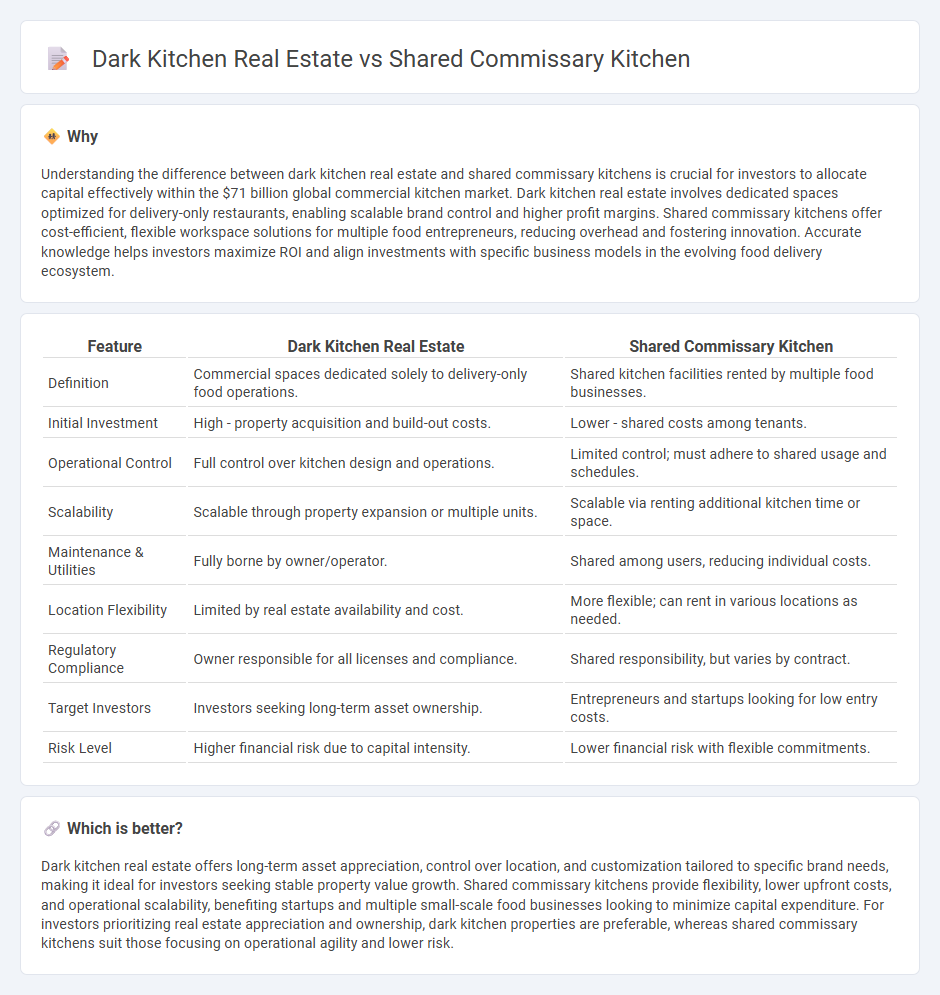
Dark kitchen real estate involves dedicated spaces designed exclusively for delivery-only food businesses, often located in high-demand urban areas to maximize delivery efficiency. Shared commissary kitchens offer scalable, fully-equipped kitchen facilities rented by multiple food entrepreneurs, reducing overhead costs and providing flexible use of premium kitchen infrastructure. Explore the key differences and benefits to determine which kitchen model best supports your investment strategy.
Why it is important
Understanding the difference between dark kitchen real estate and shared commissary kitchens is crucial for investors to allocate capital effectively within the $71 billion global commercial kitchen market. Dark kitchen real estate involves dedicated spaces optimized for delivery-only restaurants, enabling scalable brand control and higher profit margins. Shared commissary kitchens offer cost-efficient, flexible workspace solutions for multiple food entrepreneurs, reducing overhead and fostering innovation. Accurate knowledge helps investors maximize ROI and align investments with specific business models in the evolving food delivery ecosystem.
Comparison Table
| Feature | Dark Kitchen Real Estate | Shared Commissary Kitchen |
|---|---|---|
| Definition | Commercial spaces dedicated solely to delivery-only food operations. | Shared kitchen facilities rented by multiple food businesses. |
| Initial Investment | High - property acquisition and build-out costs. | Lower - shared costs among tenants. |
| Operational Control | Full control over kitchen design and operations. | Limited control; must adhere to shared usage and schedules. |
| Scalability | Scalable through property expansion or multiple units. | Scalable via renting additional kitchen time or space. |
| Maintenance & Utilities | Fully borne by owner/operator. | Shared among users, reducing individual costs. |
| Location Flexibility | Limited by real estate availability and cost. | More flexible; can rent in various locations as needed. |
| Regulatory Compliance | Owner responsible for all licenses and compliance. | Shared responsibility, but varies by contract. |
| Target Investors | Investors seeking long-term asset ownership. | Entrepreneurs and startups looking for low entry costs. |
| Risk Level | Higher financial risk due to capital intensity. | Lower financial risk with flexible commitments. |
Which is better?
Dark kitchen real estate offers long-term asset appreciation, control over location, and customization tailored to specific brand needs, making it ideal for investors seeking stable property value growth. Shared commissary kitchens provide flexibility, lower upfront costs, and operational scalability, benefiting startups and multiple small-scale food businesses looking to minimize capital expenditure. For investors prioritizing real estate appreciation and ownership, dark kitchen properties are preferable, whereas shared commissary kitchens suit those focusing on operational agility and lower risk.
Connection
Dark kitchen real estate investments focus on properties specifically designed or adapted for high-efficiency food preparation without dine-in spaces, maximizing rental income by catering to multiple delivery-only restaurant brands. Shared commissary kitchens provide cost-effective, compliant commercial kitchen spaces that support dark kitchen operators by reducing entry barriers and operational costs. This symbiotic relationship drives demand for specialized real estate, attracting investors seeking growth in the evolving food delivery and cloud kitchen market.
Key Terms
Lease Structures
Shared commissary kitchens typically offer flexible short-term leases with tiered pricing based on usage hours and services, ideal for startups and small food businesses seeking cost efficiency. Dark kitchens usually require longer-term leases with higher fixed costs and obligations due to customized build-outs and dedicated operational spaces, catering to delivery-only brands. Explore lease options to determine the optimal real estate strategy for your food business growth.
Operating Expenses
Operating expenses in shared commissary kitchens typically include rent, utilities, equipment maintenance, and shared resource fees, which are divided among multiple food businesses to reduce individual costs. Dark kitchens, primarily focused on delivery-only models, often incur higher expenses in technology integration, packaging, and dedicated staff, but benefit from lower front-of-house costs. Explore more about optimizing operating expenses for your foodservice venture by diving deeper into the distinctions between shared commissary and dark kitchen models.
Revenue Sharing
Shared commissary kitchens operate by leasing kitchen space to multiple food businesses, generating revenue primarily through rental fees and utility charges, while dark kitchens focus on delivery-only models that share revenue with restaurant partners or delivery platforms. Revenue sharing in shared commissary kitchens tends to be more predictable and fixed, whereas dark kitchens often engage in variable revenue contracts based on order volume or sales percentages. Explore the financial models and operational benefits of each kitchen type to optimize your food business strategy.
Source and External Links
Commissary Kitchen: Definition, Benefits, Use Cases & Costs - A shared commissary kitchen is a rented facility where multiple food businesses prepare and store food, offering flexible rental terms, commercial-grade equipment, and pre-certified health standards while fostering community among entrepreneurs, though with limited customization and scheduling challenges due to sharing the space.
What is a Commisary Kitchen? How can you benefit from it? - Shared commissary kitchens provide affordable access to industrial kitchen equipment and storage with hourly or monthly rentals, benefiting a wide range of food operators such as bakers, caterers, food trucks, and restaurant chains by reducing overhead while ensuring compliance with health regulations.
Commissary Kitchen: How To Rent One and How Much It Costs - A shared commissary kitchen is a professional kitchen space rented by multiple operators at different times with common commercial cooking, cold storage, dishwashing, and prep equipment available, typically operating 24/7 to accommodate various tenants' schedules and needs.
 dowidth.com
dowidth.com